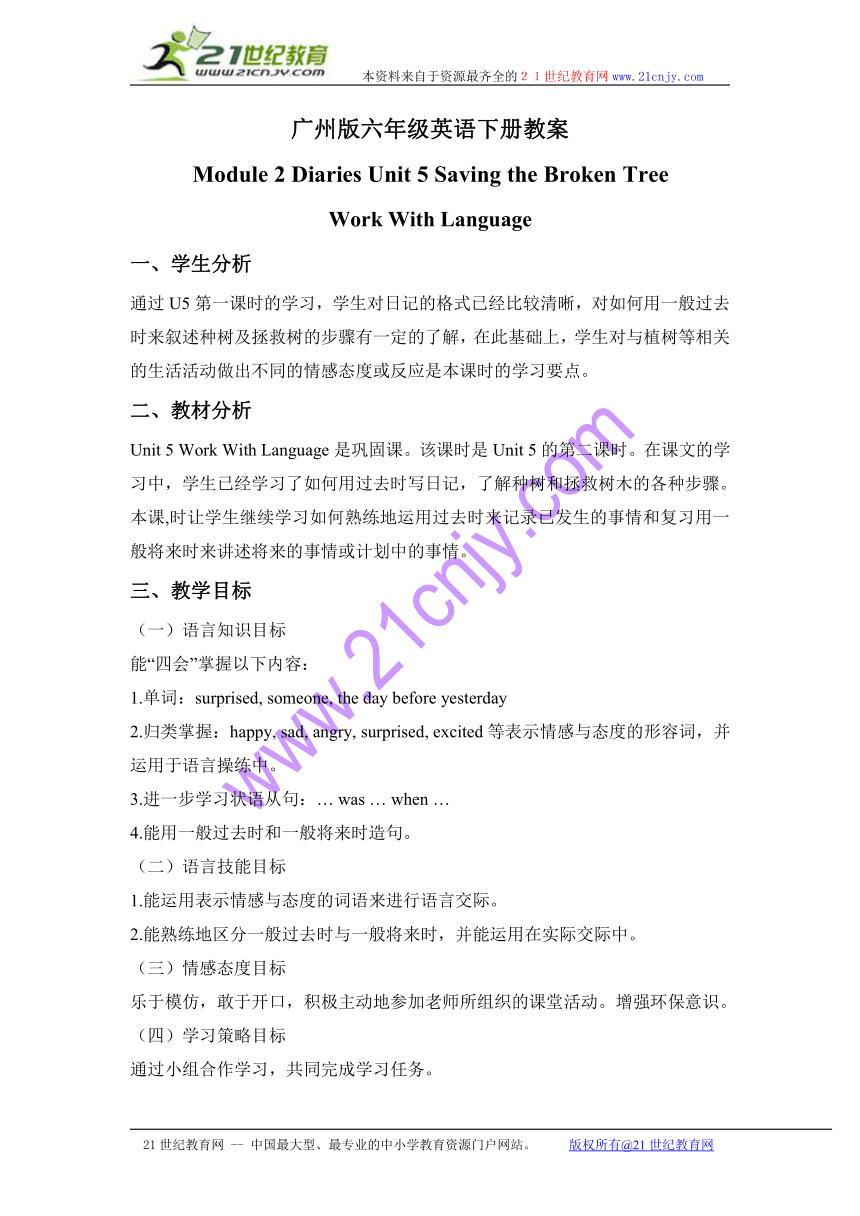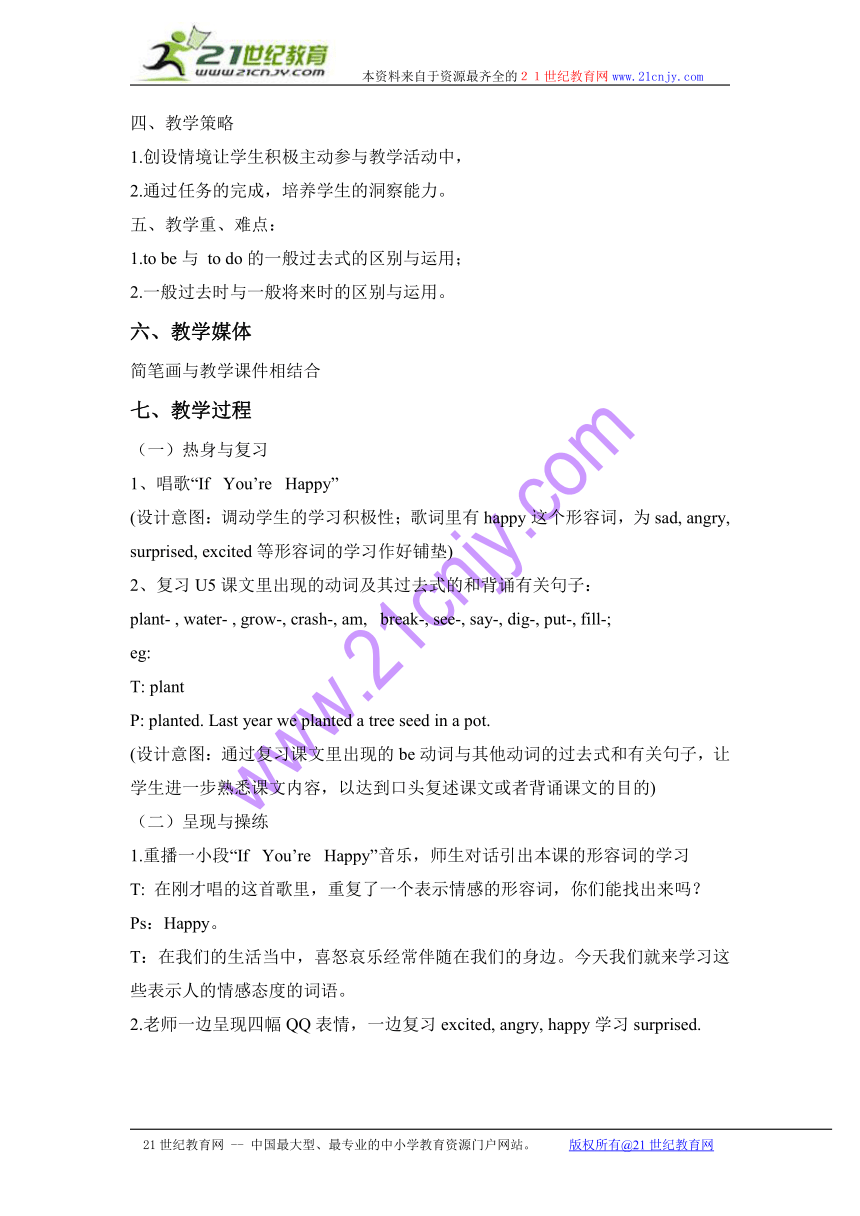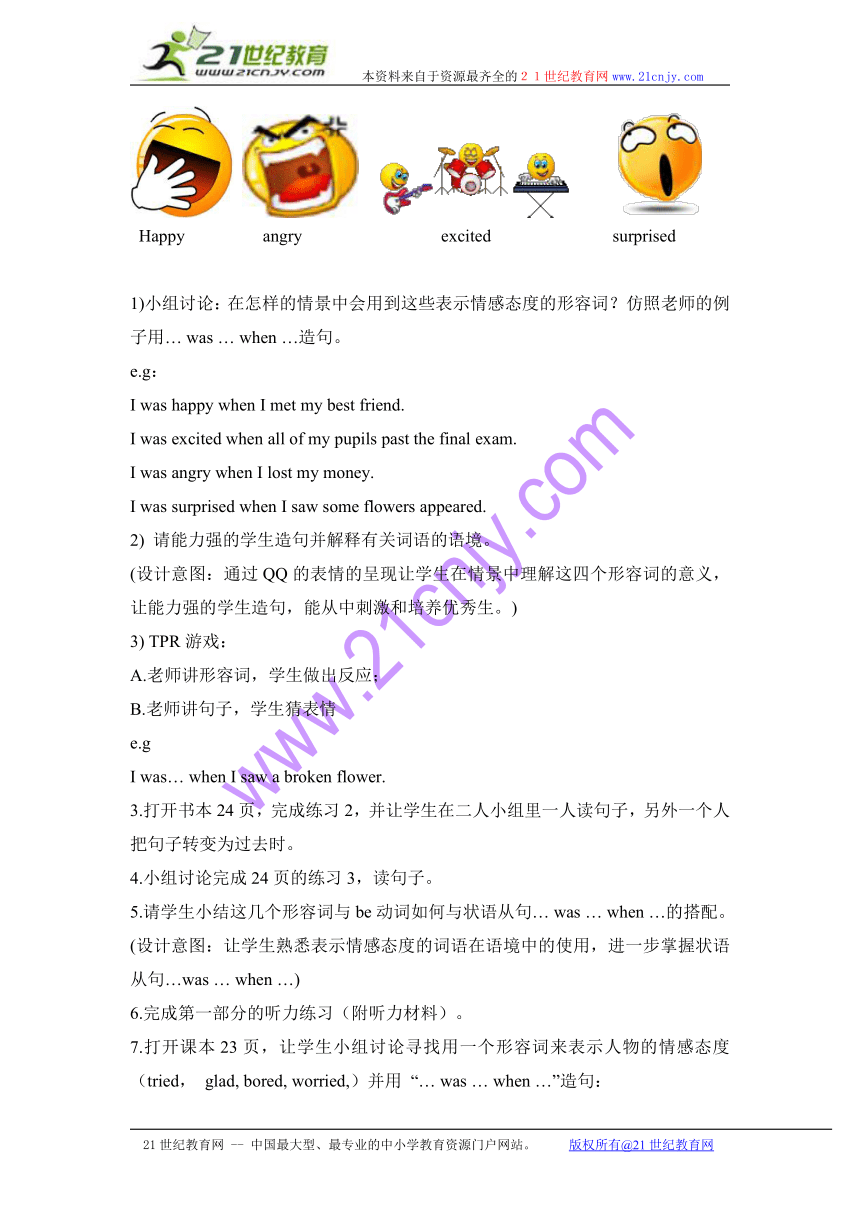六年级英语下册教案 module 2 unit 5(3)(广州版)
文档属性
| 名称 | 六年级英语下册教案 module 2 unit 5(3)(广州版) |  | |
| 格式 | rar | ||
| 文件大小 | 106.0KB | ||
| 资源类型 | 教案 | ||
| 版本资源 | 广州版 | ||
| 科目 | 英语 | ||
| 更新时间 | 2010-01-11 12:48:00 | ||
图片预览



文档简介
本资料来自于资源最齐全的21世纪教育网www.21cnjy.com
广州版六年级英语下册教案
Module 2 Diaries Unit 5 Saving the Broken Tree
Work With Language
一、学生分析
通过U5第一课时的学习,学生对日记的格式已经比较清晰,对如何用一般过去时来叙述种树及拯救树的步骤有一定的了解,在此基础上,学生对与植树等相关的生活活动做出不同的情感态度或反应是本课时的学习要点。
二、教材分析
Unit 5 Work With Language是巩固课。该课时是Unit 5的第二课时。在课文的学习中,学生已经学习了如何用过去时写日记,了解种树和拯救树木的各种步骤。本课,时让学生继续学习如何熟练地运用过去时来记录已发生的事情和复习用一般将来时来讲述将来的事情或计划中的事情。
三、教学目标
(一)语言知识目标
能“四会”掌握以下内容:
1.单词:surprised, someone, the day before yesterday
2.归类掌握:happy, sad, angry, surprised, excited等表示情感与态度的形容词,并运用于语言操练中。
3.进一步学习状语从句:… was … when …
4.能用一般过去时和一般将来时造句。
(二)语言技能目标
1.能运用表示情感与态度的词语来进行语言交际。
2.能熟练地区分一般过去时与一般将来时,并能运用在实际交际中。
(三)情感态度目标
乐于模仿,敢于开口,积极主动地参加老师所组织的课堂活动。增强环保意识。
(四)学习策略目标
通过小组合作学习,共同完成学习任务。
四、教学策略
1.创设情境让学生积极主动参与教学活动中,
2.通过任务的完成,培养学生的洞察能力。
五、教学重、难点:
1.to be与 to do的一般过去式的区别与运用;
2.一般过去时与一般将来时的区别与运用。
六、教学媒体
简笔画与教学课件相结合
七、教学过程
(一)热身与复习
1、唱歌“If You’re Happy”
(设计意图:调动学生的学习积极性;歌词里有happy这个形容词,为sad, angry, surprised, excited等形容词的学习作好铺垫)
2、复习U5课文里出现的动词及其过去式的和背诵有关句子:
plant- , water- , grow-, crash-, am, break-, see-, say-, dig-, put-, fill-;
eg:
T: plant
P: planted. Last year we planted a tree seed in a pot.
(设计意图:通过复习课文里出现的be动词与其他动词的过去式和有关句子,让学生进一步熟悉课文内容,以达到口头复述课文或者背诵课文的目的)
(二)呈现与操练
1.重播一小段“If You’re Happy”音乐,师生对话引出本课的形容词的学习
T: 在刚才唱的这首歌里,重复了一个表示情感的形容词,你们能找出来吗?
Ps:Happy。
T:在我们的生活当中,喜怒哀乐经常伴随在我们的身边。今天我们就来学习这些表示人的情感态度的词语。
2.老师一边呈现四幅QQ表情,一边复习excited, angry, happy学习surprised.
Happy angry excited surprised
1)小组讨论:在怎样的情景中会用到这些表示情感态度的形容词?仿照老师的例子用… was … when …造句。
e.g:
I was happy when I met my best friend.
I was excited when all of my pupils past the final exam.
I was angry when I lost my money.
I was surprised when I saw some flowers appeared.
2) 请能力强的学生造句并解释有关词语的语境。
(设计意图:通过QQ的表情的呈现让学生在情景中理解这四个形容词的意义,让能力强的学生造句,能从中刺激和培养优秀生。)
3) TPR游戏:
A.老师讲形容词,学生做出反应;
B.老师讲句子,学生猜表情
e.g
I was… when I saw a broken flower.
3.打开书本24页,完成练习2,并让学生在二人小组里一人读句子,另外一个人把句子转变为过去时。
4.小组讨论完成24页的练习3,读句子。
5.请学生小结这几个形容词与be动词如何与状语从句… was … when …的搭配。
(设计意图:让学生熟悉表示情感态度的词语在语境中的使用,进一步掌握状语从句…was … when …)
6.完成第一部分的听力练习(附听力材料)。
7.打开课本23页,让学生小组讨论寻找用一个形容词来表示人物的情感态度(tried, glad, bored, worried,)并用 “… was … when …”造句:
e.g:
I think the boy was tired when he answered lots of phone calls.
(设计意图:温故知新,熟练掌握状语从句和在学过的知识当中归纳出更过的表示情感态度的词语)
8.师生对话引出一般过去时与一般将来时的对比学习。
1)T: I went boating with my daughter last Sunday. I was really excited. I am going boating next week . I am going to be excited again.
我们一起来讨论一下如何用英语来表示已经做了的事情和准备做、计划中的事情。
2)学生分组口头完成练习
3)小组内选择一题笔头完成。
4) 小组讨论:一般过去时与一般将来时在提示词、谓语部分的区别。老师小结。
(设计意图:让学生进一步掌握两种时态的区别与运用。)
(三)拓展与运用
1.阅读练习:
2.根据中文把下列句子补充完整。
1)The sunflowers ____________________________ (长得很好).
2)He ____________________ (感到悲伤)when he saw the broken flower.
3)We _____________________________(准备种树) by the lake.
(设计意图:通过层次分明的练习,让学生能尽快掌握本节课的知识点)
(四)布置作业
1.完成《活动手册》23页第五题的练习
2.抄写本课的词组与句子
3.收集一些落叶、花的标本,上网搜索有关的资料,为下一节课做好准备。
4.关于几种时态的语法练习。
(设计意图:通过层次分明的练习,让学生能巩固掌握本节课的知识点)
八、板书设计
U5 Work With Language
…was … when… 一般过去时 did \was\had
happy
sad
angry 一般将来时 be going to+ do(动词原形)
excited will + be\do(动词原形)
surprised
九、教学反思
本课时能较好地围绕重点难点来开展各项教学活动, 能充分发挥歌曲与QQ的表情的作用,在一般将来时与一般过去时的对比中,由于时间匆促,堂上的训练不足,所以课后还要多加训练才能帮助学生更好地理解与正确运用。
十、附件:
1.歌词:“If You’re Happy”
If you’re happy and you know it ,clap your hands.
If you’re happy and you know it ,clap your hands.
If you’re happy and you know it and you really want to show it.
If you’re happy and you know it, clap your hands.
(stamp your feet\ touch your nose\say OK \say goodbye替换划线部分。)
2.听力材料:
A. He went climbing last Sunday.
B. He answered a lot of phone calls last Sunday.
C. He picked apples on a farm last Sunday.
D. He practiced playing football last Sunday.
E. They went to a concert last Sunday.
F. They went to a circus last Sunday.
3.阅读材料:
读短文,选出问题的正确答案:
Twenty years ago, when Mr Li was a child, he dug a hole beside his old house and planted a young kapok tree there. Last week when he came back to his old house, he found the tree was big and tall. And there were a lot of beautiful red flowers on it. The friends said the tree grew well and they could have flowers every year. People there picked up the flowers to make Chinese medicine. The children often played under the big kapok tree. He was very happy to see the kapok tree. He hoped it could grow taller and bigger.
( ) (1) when did Mr Li grow tree beside his old house
A. 30 years ago.
B. 20 years ago.
C.40 years ago.
( ) (2)What tree is it
A.A banyan tree.
B. An oak tree.
C. A kapok tree.
( ) (3)How is the tree now
A. It is broken.
B. It was not there.
C. It grows well.
( ) (4)Why did the people pick up the kapok flowers
A. They used it as medicine.
B. They decorate their house with them.
C. They ate them.
( ) (5) Did the children often play under the kapok tree
A. Yes, they did.
B. No, they didn’t.
C. Only sometimes.
4.用适当的动词形式填空。
1. He __________(help) us with our homework every evening.
2. My grandfather ______________(leave) for Beijing next Sunday.
3. The children ______________(plant) trees on the hills last week.
4. Look at the old man. He ____________(water) the flowers.
5. Miss Li _____________(get) to school at seven this morning.
6. ____________ Mr. Chen ____________(wash) his dog every day
7. ____________ Lily _____________(go) fishing yesterday
8. ___________ Mike ____________(meet) his friends last Wednesday
21世纪教育网21世纪教育网
21世纪教育网 -- 中国最大型、最专业的中小学教育资源门户网站。 版权所有@21世纪教育网
广州版六年级英语下册教案
Module 2 Diaries Unit 5 Saving the Broken Tree
Work With Language
一、学生分析
通过U5第一课时的学习,学生对日记的格式已经比较清晰,对如何用一般过去时来叙述种树及拯救树的步骤有一定的了解,在此基础上,学生对与植树等相关的生活活动做出不同的情感态度或反应是本课时的学习要点。
二、教材分析
Unit 5 Work With Language是巩固课。该课时是Unit 5的第二课时。在课文的学习中,学生已经学习了如何用过去时写日记,了解种树和拯救树木的各种步骤。本课,时让学生继续学习如何熟练地运用过去时来记录已发生的事情和复习用一般将来时来讲述将来的事情或计划中的事情。
三、教学目标
(一)语言知识目标
能“四会”掌握以下内容:
1.单词:surprised, someone, the day before yesterday
2.归类掌握:happy, sad, angry, surprised, excited等表示情感与态度的形容词,并运用于语言操练中。
3.进一步学习状语从句:… was … when …
4.能用一般过去时和一般将来时造句。
(二)语言技能目标
1.能运用表示情感与态度的词语来进行语言交际。
2.能熟练地区分一般过去时与一般将来时,并能运用在实际交际中。
(三)情感态度目标
乐于模仿,敢于开口,积极主动地参加老师所组织的课堂活动。增强环保意识。
(四)学习策略目标
通过小组合作学习,共同完成学习任务。
四、教学策略
1.创设情境让学生积极主动参与教学活动中,
2.通过任务的完成,培养学生的洞察能力。
五、教学重、难点:
1.to be与 to do的一般过去式的区别与运用;
2.一般过去时与一般将来时的区别与运用。
六、教学媒体
简笔画与教学课件相结合
七、教学过程
(一)热身与复习
1、唱歌“If You’re Happy”
(设计意图:调动学生的学习积极性;歌词里有happy这个形容词,为sad, angry, surprised, excited等形容词的学习作好铺垫)
2、复习U5课文里出现的动词及其过去式的和背诵有关句子:
plant- , water- , grow-, crash-, am, break-, see-, say-, dig-, put-, fill-;
eg:
T: plant
P: planted. Last year we planted a tree seed in a pot.
(设计意图:通过复习课文里出现的be动词与其他动词的过去式和有关句子,让学生进一步熟悉课文内容,以达到口头复述课文或者背诵课文的目的)
(二)呈现与操练
1.重播一小段“If You’re Happy”音乐,师生对话引出本课的形容词的学习
T: 在刚才唱的这首歌里,重复了一个表示情感的形容词,你们能找出来吗?
Ps:Happy。
T:在我们的生活当中,喜怒哀乐经常伴随在我们的身边。今天我们就来学习这些表示人的情感态度的词语。
2.老师一边呈现四幅QQ表情,一边复习excited, angry, happy学习surprised.
Happy angry excited surprised
1)小组讨论:在怎样的情景中会用到这些表示情感态度的形容词?仿照老师的例子用… was … when …造句。
e.g:
I was happy when I met my best friend.
I was excited when all of my pupils past the final exam.
I was angry when I lost my money.
I was surprised when I saw some flowers appeared.
2) 请能力强的学生造句并解释有关词语的语境。
(设计意图:通过QQ的表情的呈现让学生在情景中理解这四个形容词的意义,让能力强的学生造句,能从中刺激和培养优秀生。)
3) TPR游戏:
A.老师讲形容词,学生做出反应;
B.老师讲句子,学生猜表情
e.g
I was… when I saw a broken flower.
3.打开书本24页,完成练习2,并让学生在二人小组里一人读句子,另外一个人把句子转变为过去时。
4.小组讨论完成24页的练习3,读句子。
5.请学生小结这几个形容词与be动词如何与状语从句… was … when …的搭配。
(设计意图:让学生熟悉表示情感态度的词语在语境中的使用,进一步掌握状语从句…was … when …)
6.完成第一部分的听力练习(附听力材料)。
7.打开课本23页,让学生小组讨论寻找用一个形容词来表示人物的情感态度(tried, glad, bored, worried,)并用 “… was … when …”造句:
e.g:
I think the boy was tired when he answered lots of phone calls.
(设计意图:温故知新,熟练掌握状语从句和在学过的知识当中归纳出更过的表示情感态度的词语)
8.师生对话引出一般过去时与一般将来时的对比学习。
1)T: I went boating with my daughter last Sunday. I was really excited. I am going boating next week . I am going to be excited again.
我们一起来讨论一下如何用英语来表示已经做了的事情和准备做、计划中的事情。
2)学生分组口头完成练习
3)小组内选择一题笔头完成。
4) 小组讨论:一般过去时与一般将来时在提示词、谓语部分的区别。老师小结。
(设计意图:让学生进一步掌握两种时态的区别与运用。)
(三)拓展与运用
1.阅读练习:
2.根据中文把下列句子补充完整。
1)The sunflowers ____________________________ (长得很好).
2)He ____________________ (感到悲伤)when he saw the broken flower.
3)We _____________________________(准备种树) by the lake.
(设计意图:通过层次分明的练习,让学生能尽快掌握本节课的知识点)
(四)布置作业
1.完成《活动手册》23页第五题的练习
2.抄写本课的词组与句子
3.收集一些落叶、花的标本,上网搜索有关的资料,为下一节课做好准备。
4.关于几种时态的语法练习。
(设计意图:通过层次分明的练习,让学生能巩固掌握本节课的知识点)
八、板书设计
U5 Work With Language
…was … when… 一般过去时 did \was\had
happy
sad
angry 一般将来时 be going to+ do(动词原形)
excited will + be\do(动词原形)
surprised
九、教学反思
本课时能较好地围绕重点难点来开展各项教学活动, 能充分发挥歌曲与QQ的表情的作用,在一般将来时与一般过去时的对比中,由于时间匆促,堂上的训练不足,所以课后还要多加训练才能帮助学生更好地理解与正确运用。
十、附件:
1.歌词:“If You’re Happy”
If you’re happy and you know it ,clap your hands.
If you’re happy and you know it ,clap your hands.
If you’re happy and you know it and you really want to show it.
If you’re happy and you know it, clap your hands.
(stamp your feet\ touch your nose\say OK \say goodbye替换划线部分。)
2.听力材料:
A. He went climbing last Sunday.
B. He answered a lot of phone calls last Sunday.
C. He picked apples on a farm last Sunday.
D. He practiced playing football last Sunday.
E. They went to a concert last Sunday.
F. They went to a circus last Sunday.
3.阅读材料:
读短文,选出问题的正确答案:
Twenty years ago, when Mr Li was a child, he dug a hole beside his old house and planted a young kapok tree there. Last week when he came back to his old house, he found the tree was big and tall. And there were a lot of beautiful red flowers on it. The friends said the tree grew well and they could have flowers every year. People there picked up the flowers to make Chinese medicine. The children often played under the big kapok tree. He was very happy to see the kapok tree. He hoped it could grow taller and bigger.
( ) (1) when did Mr Li grow tree beside his old house
A. 30 years ago.
B. 20 years ago.
C.40 years ago.
( ) (2)What tree is it
A.A banyan tree.
B. An oak tree.
C. A kapok tree.
( ) (3)How is the tree now
A. It is broken.
B. It was not there.
C. It grows well.
( ) (4)Why did the people pick up the kapok flowers
A. They used it as medicine.
B. They decorate their house with them.
C. They ate them.
( ) (5) Did the children often play under the kapok tree
A. Yes, they did.
B. No, they didn’t.
C. Only sometimes.
4.用适当的动词形式填空。
1. He __________(help) us with our homework every evening.
2. My grandfather ______________(leave) for Beijing next Sunday.
3. The children ______________(plant) trees on the hills last week.
4. Look at the old man. He ____________(water) the flowers.
5. Miss Li _____________(get) to school at seven this morning.
6. ____________ Mr. Chen ____________(wash) his dog every day
7. ____________ Lily _____________(go) fishing yesterday
8. ___________ Mike ____________(meet) his friends last Wednesday
21世纪教育网21世纪教育网
21世纪教育网 -- 中国最大型、最专业的中小学教育资源门户网站。 版权所有@21世纪教育网
同课章节目录
- Module 1 Stories
- Unit 1 Slow and steady wins the race
- Unit 2 Waiting for another hare
- Module 2 Animals
- Unit 3 What animal is it?
- Unit 4 We can save the animals
- Module 3 Famous people
- Unit 5 Dr Sun Yatsen
- Unit 6 Steve Jobs
- Module 4 Good manners
- Unit 7 It's the polite thing to do
- Unit 8 The magic words
- Module 5 Travel abroad
- Unit 9 Where will you go?
- Unit 10 I can't wait to see you
- Module 6 Let's look back
